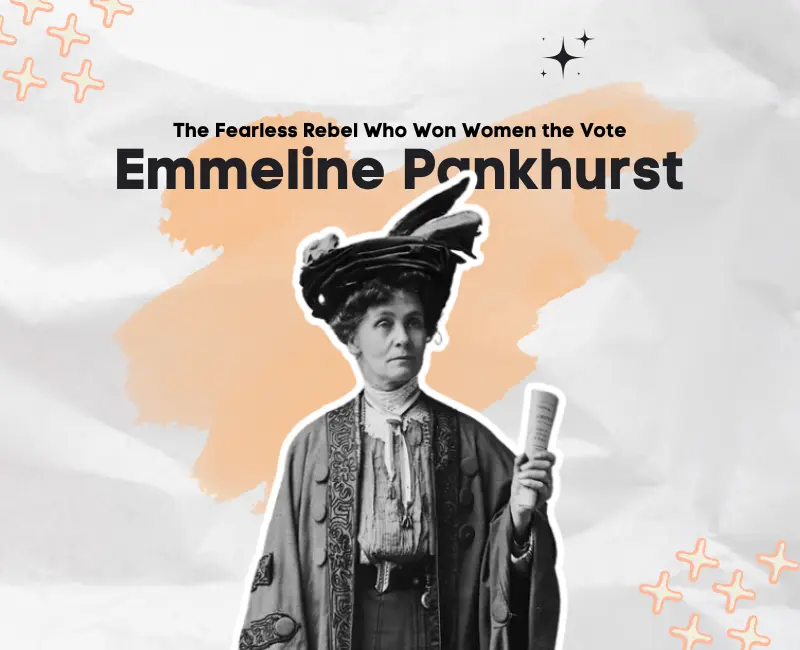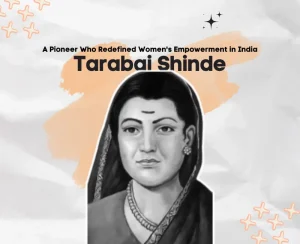Emmeline Pankhurst: The Fearless Rebel Who Won Women the Vote

Emmeline Pankhurst (1858–1928) was a trailblazing activist who led the charge for women’s suffrage in Britain. Known for her bold tactics and unshakable resolve, she transformed the fight for voting rights into a powerful, attention-grabbing movement that reshaped British society. In 1903, frustrated by decades of inaction, she founded the Women’s Social and Political Union (WSPU), which embraced the motto “Deeds, not words.” The WSPU’s militant strategies, including protests, hunger strikes, and acts of civil disobedience, forced the issue of women’s suffrage into the national spotlight.
Pankhurst’s unrelenting determination came at a significant personal cost, including frequent arrests and harsh treatment during imprisonment. Yet, her efforts and those of countless suffragettes laid the foundation for transformative legal changes. Her leadership helped secure voting rights for women over 30 in 1918 and inspired future generations of feminists worldwide.
Today, Pankhurst is an enduring symbol of courage and social progress, her legacy immortalized in statues and history books. Her story is a testament to the power of persistence and the impact of standing firm in the face of injustice.
Early Life and Education
Emmeline Pankhurst was born Emmeline Goulden on July 15, 1858, in Moss Side, Manchester, into a politically active and reform-minded family. Her parents, Robert and Sophia Goulden, were passionate advocates for social justice, particularly the abolition of slavery and women’s rights. Growing up in this environment, Emmeline was exposed to progressive ideas from an early age. Although education for girls in the 19th century was often limited, her parents encouraged her to develop a strong intellect and a deep sense of justice. By age 14, she attended her first women’s suffrage meeting, an experience that profoundly shaped her ambitions and commitment to gender equality.
In her late teens, Emmeline moved to Paris to attend the École Normale Supérieure, a progressive girls’ school. She was exposed to advanced thinking on education, science, and women’s societal roles. This international perspective broadened her understanding of social reform and further fueled her desire to challenge the gender norms of her time. Unlike many of her contemporaries, Emmeline received an education that encouraged critical thinking and a belief in the possibility of social change—the time she spent in France instilled in her a lifelong belief in women’s potential to transform society when given equal opportunities.
In 1879, Emmeline married Richard Pankhurst, a lawyer and staunch supporter of women’s suffrage. Richard’s work as a legal reformer, including his involvement in drafting the Married Women’s Property Act of 1870, reinforced her conviction that systemic change was necessary to achieve gender equality. Together, they shared a vision of social reform, and their home became a hub for political discussions. Richard’s unwavering support of women’s suffrage and his progressive ideas profoundly influenced Emmeline’s later activism. His early death in 1898 left her widowed with five children, but it also became a turning point in her life, compelling her to channel her grief into focused activism. Her experiences as a mother, wife, and widow shaped her understanding of the systemic barriers women faced, igniting her determination to dismantle them.
The Founding of the WSPU
In 1903, Emmeline Pankhurst, frustrated by the slow and ineffective progress of traditional suffrage campaigns, founded the Women’s Social and Political Union (WSPU) in Manchester. The organization was created as a breakaway from more moderate suffrage groups like the National Union of Women’s Suffrage Societies (NUWSS), which relied heavily on petitions and parliamentary lobbying. Emmeline believed these methods were too passive to achieve real change. The WSPU’s motto, “Deeds, not words,” reflected its mission to use direct action to compel the government to grant women the right to vote. With this, the WSPU distinguished itself as a radical and militant organization, unafraid to disrupt the status quo.
The WSPU initially focused on holding rallies, delivering speeches, and organizing marches to raise public awareness. However, as government resistance persisted, the organization escalated its tactics. Under Pankhurst’s leadership, the suffragettes moved to more aggressive forms of protest, including heckling politicians during speeches, disrupting public events, and staging sit-ins at government offices. These bold actions attracted widespread media attention, helping the WSPU amplify its message. However, they also made the group a target of criticism, with opponents branding its members as lawbreakers and extremists. Unperturbed by the backlash, Pankhurst argued that drastic measures were necessary to challenge deeply entrenched gender inequality.
One of the WSPU’s defining features was its focus on female autonomy and leadership. Unlike other suffrage organizations often dominated by male allies, the WSPU was unapologetically women-led. Emmeline’s daughters, Christabel and Sylvia Pankhurst were central figures in the movement, each contributing their talents and vision to the cause. Christabel’s strategic brilliance helped shape the group’s militant approach, while Sylvia used her artistic skills to design banners and publications that spread the WSPU’s message. This emphasis on women’s agency advanced the suffrage cause and empowered women to see themselves as capable leaders and changemakers. Through the WSPU, Emmeline Pankhurst galvanized thousands of women across Britain, transforming the fight for voting rights into a nationwide campaign for justice.
Arrests and Hunger Strikes
Emmeline Pankhurst’s activism often placed her in direct conflict with the law, leading to numerous arrests throughout her life. As the Women’s Social and Political Union (WSPU) leader, she orchestrated high-profile campaigns designed to disrupt the status quo and draw attention to the suffrage cause. These actions—from organizing demonstrations to orchestrating civil disobedience like breaking windows or chaining themselves to government buildings—frequently led to arrests. Pankhurst herself was arrested multiple times, often charged with offenses such as disturbing the peace or conspiracy. Each arrest became a platform to amplify the suffragettes’ message, transforming her trials and incarcerations into opportunities to highlight the injustice faced by women.
Life in prison for Pankhurst and her fellow suffragettes was harsh and unyielding. Conditions were grim, and the suffragettes were not treated as political prisoners but as common criminals, a deliberate attempt to undermine the legitimacy of their cause. In protest against this treatment, Pankhurst and others engaged in hunger strikes, refusing food to assert their dignity and drawing public attention to their plight. The government’s response was brutal; authorities resorted to force-feeding, a painful and invasive procedure that caused severe physical and psychological harm. These force-feedings generated widespread public outrage, garnering sympathy for the suffragettes and further polarizing the debate on women’s rights.
The hunger strikes symbolized the suffragettes’ resilience and the lengths they were willing to go for equality. Pankhurst’s suffering became symbolic of the broader struggle for women’s suffrage. Her repeated arrests and the government’s harsh treatment of hunger strikers drew attention to the moral bankruptcy of denying women the vote while subjecting them to such inhumane conditions. Over time, these events shifted public opinion and political attitudes, forcing the issue of women’s suffrage into the legislative arena. Pankhurst’s defiance in the face of adversity highlighted the determination of the movement and demonstrated the extraordinary sacrifices made by women to secure fundamental democratic rights.
Role During World War I
When World War I erupted in 1914, Emmeline Pankhurst made a pivotal decision that temporarily altered the direction of the women’s suffrage movement. Recognizing the gravity of the war and the necessity of national unity, she paused the militant activities of the Women’s Social and Political Union (WSPU). Alongside her daughters Christabel and Sylvia, Pankhurst shifted the focus from suffrage to supporting the war effort, believing that women’s contributions during this critical time would prove their capability and strengthen the case for equal rights. This move demonstrated Pankhurst’s pragmatism and aligned the suffrage movement with the broader national interest, securing new allies and public support.
Pankhurst urged women to step into roles traditionally reserved for men, who were now fighting on the front lines. She encouraged women to work in factories, join auxiliary military units, and take up roles in public service, agriculture, and transportation. The WSPU even launched a campaign to recruit women into munitions work actively, coining the term “munitionettes” to honor their contribution. These efforts bolstered Britain’s war capacity and shattered societal perceptions of women as solely domestic figures, proving they were essential to the nation’s survival in times of crisis.
Pankhurst’s support for the war effort was not without controversy. Some critics, including members of her own family, viewed her alignment with the government as a betrayal of the movement’s radical roots. However, this strategy ultimately paid off. Women’s indispensable role in sustaining the war effort changed public attitudes and influenced political leaders to recognize their right to vote. The passage of the Representation of the People Act in 1918, which granted voting rights to women over 30, was a direct acknowledgment of their wartime contributions. Pankhurst’s wartime leadership was instrumental in transforming women’s status in society, showing that voting was not just a political issue but a matter of justice for those who had proven their worth under extraordinary circumstances.
Victory and Legacy
The victory for women’s suffrage in Britain was a historic milestone, achieved after decades of tireless campaigning, with Emmeline Pankhurst as one of its most influential leaders. In 1918, the Representation of the People Act was passed, granting voting rights to women over 30 who met specific property qualifications. While this fell short of full equality, it marked the first time women were legally recognized as voters in the British political system. This significant step forward was a testament to the relentless efforts of Pankhurst and the Women’s Social and Political Union (WSPU), whose high-profile activism had kept the issue at the forefront of public consciousness. Their sacrifices, from imprisonment to hunger strikes, forced the government to confront the demand for gender equality.
Pankhurst’s legacy extends far beyond the 1918 legislation. She paved the way for subsequent advancements in women’s rights, and her life symbolized courage and determination in the face of adversity. Her leadership style—bold, uncompromising, and unapologetic—challenged traditional gender norms and inspired women worldwide to assert their rights. Even after the suffrage battle, Pankhurst advocated for social reforms, including efforts to address poverty and inequality. In 1928, the Equal Franchise Act was passed, lowering the voting age for women to 21 and granting them electoral parity with men. Although Emmeline Pankhurst did not live to see this final victory, her work was instrumental in its achievement.
Today, Pankhurst is celebrated as one of the most important figures in the history of women’s rights. Statues of her stand in Manchester and near Parliament in London are a lasting tribute to her contributions. Her story has been memorialized in books, documentaries, and films, ensuring her legacy inspires new generations. Pankhurst’s life is a powerful reminder of the impact of grassroots activism and the enduring importance of fighting for equality. Even in the face of immense opposition, she showed that change is possible when driven by passion, strategy, and unwavering belief in justice.
A Lasting Impact
Emmeline Pankhurst’s contributions to the fight for women’s suffrage left an indelible mark on the fabric of British society and beyond. Her tireless efforts and strategic vision transformed what was once a marginalized movement into a powerful force for change. By adopting militant tactics and refusing to accept slow reform, Pankhurst galvanized supporters and detractors, ensuring the suffrage cause could not be ignored. Her leadership inspired thousands of women to join the fight, fostering a sense of solidarity and empowerment that continues to resonate in modern feminist movements.
The passing of the Representation of the People Act in 1918, which granted partial voting rights to women, was a direct outcome of the relentless campaigning led by Pankhurst and her allies. Although not the full equality she envisioned, it marked a significant turning point, affirming women’s political power in Britain. The subsequent lowering of the voting age for women to 21 in 1928—achieving parity with men—culminated years of sacrifice and advocacy. Pankhurst did not live to see this final victory, but her role in its realization is undeniable. Her work not only transformed the lives of British women but also served as an inspiration for suffrage movements worldwide, from the United States to New Zealand.
Today, Emmeline Pankhurst remains a symbol of courage and progress. Her legacy is celebrated in numerous ways, including statues in her honor, such as the one near the UK Parliament. These tributes are more than just memorials; they serve as reminders of the power of collective action and the importance of challenging societal norms. Her story inspires new generations to fight for equality and justice, reminding us that meaningful change often requires persistence, courage, and an unwavering belief in the cause. Emmeline Pankhurst’s life is a testament to the profound impact that determined individuals can have on history.
Conclusion
Emmeline Pankhurst’s relentless pursuit of women’s suffrage transformed British society and set a global example for social activism. Her bold actions, from protests to imprisonment, led to significant legal victories, culminating in women gaining the right to vote on equal terms with men in 1928. Pankhurst’s legacy inspires movements for gender equality and human rights worldwide. Her story serves as a reminder that progress often requires challenging the status quo and embracing bold strategies to achieve lasting change, making her an enduring symbol of courage and activism.


